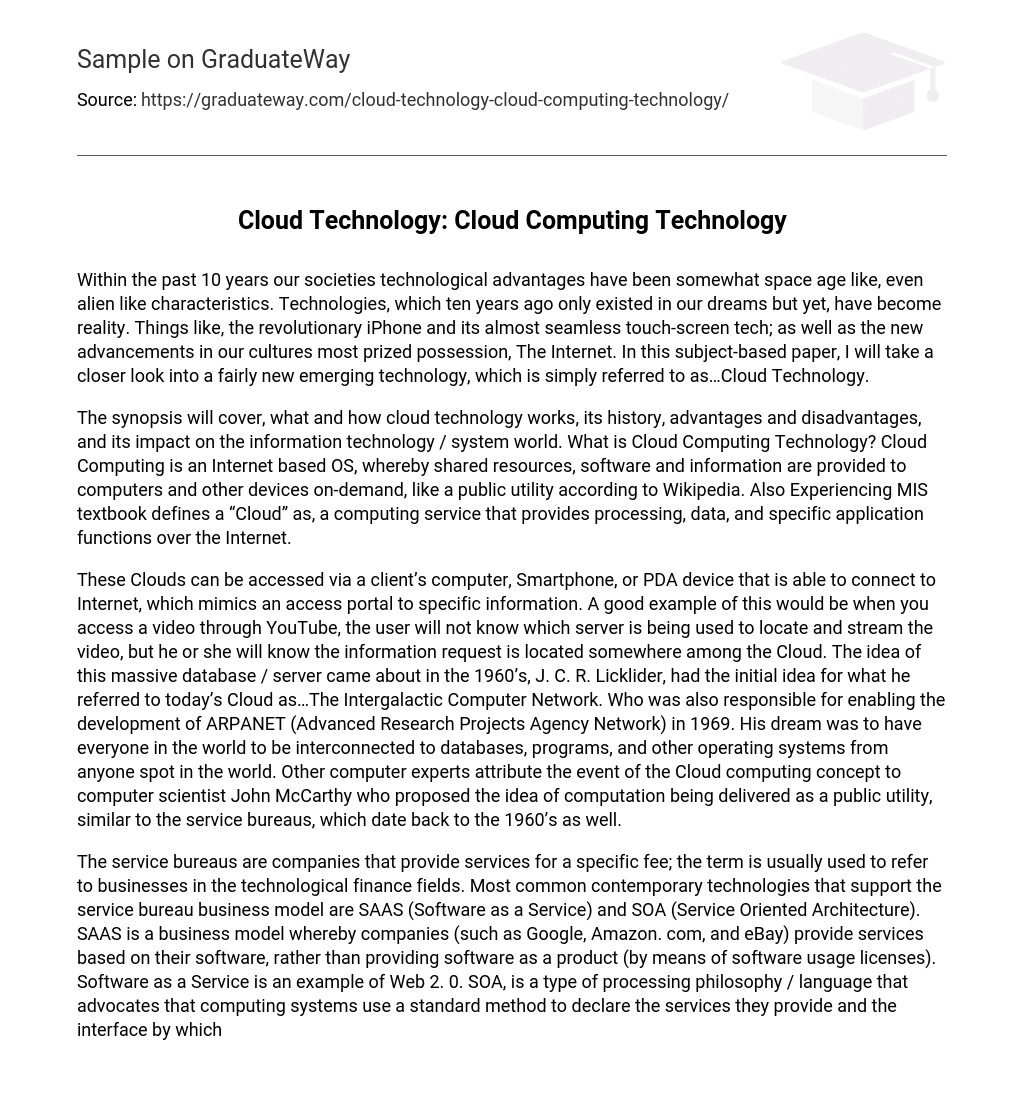In recent years, our society has experienced extraordinary technological progress that appears almost surreal. These advancements, previously only imagined, are now an integral part of our daily lives. Notable examples include the revolutionary iPhone with its exceptional touch-screen technology and the ongoing improvements in the internet – an invaluable resource for our society. The focus of this paper is on Cloud Technology, a developing innovation that deserves further investigation.
The synopsis will discuss the working principles, history, benefits, drawbacks, and influence of cloud technology on the world of information technology/systems. Cloud Computing Technology refers to an Internet-based operating system that offers shared resources, software, and information on demand to computers and other devices, similar to a public utility (as per Wikipedia). The textbook “Experiencing MIS” defines a “Cloud” as a computing service that delivers processing power, data, and specific application functions through the Internet.
The Cloud allows access to specific information through a client’s computer, Smartphone, or PDA device connected to the Internet. It functions as a portal for requesting information, similar to accessing a video on YouTube without knowing which server is used. This concept of a massive database/server originated in the 1960’s with J.C.R Licklider’s idea of the Intergalactic Computer Network. Licklider also played a role in the development of ARPANET in 1969, aiming to connect people worldwide to databases, programs, and operating systems. Computer scientist John McCarthy is also credited with proposing the idea of Cloud computing as a public utility, similar to service bureaus from the 1960’s.
Service bureaus are companies that charge a fee for providing specific services, typically in the technological finance industries. The most common technologies that support the service bureau business model are SAAS (Software as a Service) and SOA (Service Oriented Architecture). SAAS is a business model where companies like Google, Amazon.com, and eBay offer services based on their software, rather than selling software through licenses. SAAS is an example of Web 2.0. SOA is a processing philosophy/language that promotes the use of a standard method for declaring and requesting computing services. Web services are an implementation of SOA. Apple is a front-runner in cloud computing technology and has recently revamped its Mac cloud computing server, known as MobileMe. MobileMe is an online storage, email, calendar, data, and document cloud that seamlessly integrates with Apple iTunes and Mac operating systems.
Cloud computing works by storing all the thoughts, remarks, and comments of a user in the Cloud above their head, similar to a comic strip character. This allows the character to access those thoughts from anywhere within the comic strip at any time. The diagram below illustrates how the Cloud can be integrated with various Internet surf-able devices like computers, smartphones, and PDAs. Productivity in the e-commerce industry, particularly for B2C merchant and non-merchant companies, has greatly benefited from the impact of cloud computing.
An ordinary information system for B2C provides an application or virtual storefront in which customers can enter and manage their orders in the Cloud/Network. E-Commerce involves the electronic buying and selling of goods and services over a private and/or public computer network, typically the Internet. As a customer, you would select a product online using the network and finalize the purchase through it. This transaction is also known as a Clearinghouse or electronic exchange.
Majority of e-commerce applications follow a three-tier architecture, illustrated in Figure 8-5 of the Experiencing MIS textbook. The architecture consists of a user tier, server tier, and database tier. The user tier includes computers with browsing capabilities that request and process web pages, databases, and utilize Cloud technology and Web 2.0. The server tier comprises computers running Web servers that generate Web pages, Cloud locations, and other data in response to browser requests. These servers also handle application programs.
The database tier is essential for running database management systems (DBMS) and processing structured query language (SQL) to store and receive data. Despite its effectiveness, e-commerce faces several challenges including channel conflicts, pricing issues, logistical expenses, and customer-service expenses. Cloud computing technology is widely utilized by internet devices, but there are both advantages and disadvantages that could impact its growth in the long run.
The technology has several apparent advantages. These include reduced capital expenditure to operational expenditure, which lowers entry barriers over time. Additionally, the computing cloud offers improved continuity for businesses and lessens the chances of data loss. Lastly, centralized data provides increased security for sensitive information.
Devices, on the other hand, allow users to access the system from any operational web browsing device. Many disadvantages of cloud computing manifest in various aspects. Smaller businesses benefit from Cloud technology more than larger corporations due to trust concerns between the storage provider (Cloud facilitator) and the companies. Additionally, even if a company can collaborate with a cloud facilitator, security issues pose a major problem for those corporations entrusting sensitive information with these cloud storage elements.
Despite the prevailing issues, companies continue to turn to cloud computing as a backup option. However, concerns still persist even when using third-party storage. These concerns include the risk of hacking, difficulties in accessing the server housing the data, and the potential permanent shutdown of the cloud storage provider, resulting in the data becoming irretrievable.





